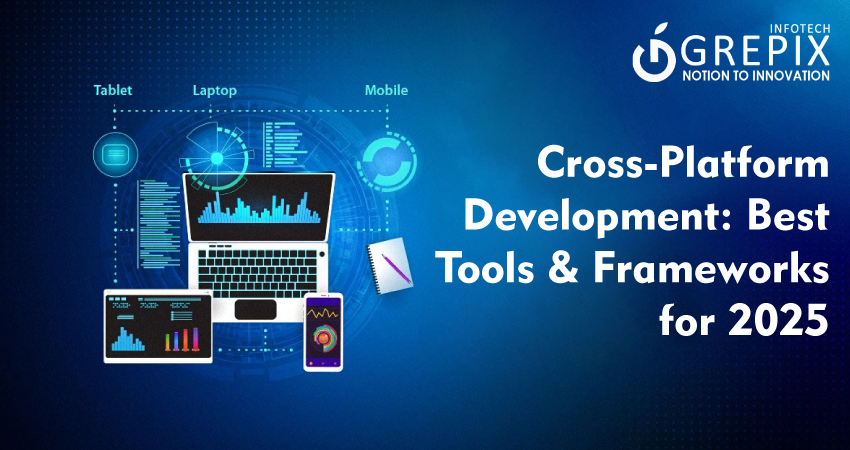Cross-Platform Development: Best Tools & Frameworks for 2025
Mobile app development is undergoing a radical transformation in 2025, with businesses and developers increasingly embracing cross-platform app development for its speed, cost savings, and ability to reach users on any device or operating system. The days of building separate native apps for iOS, Android, and web are fading, replaced by powerful cross-platform frameworks offering unified codebases and consistent user experiences.
Why is cross platform development so crucial in 2025? The answer lies in the evolving expectations: shorter launch cycles, tight budgets, global audiences, and ever-changing device ecosystems. Cross-platform app development allows companies to build and maintain applications efficiently, accelerate updates, and keep UX consistent across all platforms.
These frameworks especially Flutter and React Native lead the charge, with flexible designs, improved performance, and strong communities. The evolution of these tools means app development companies and solo founders can now achieve native-like performance, robust integrations, and innovative UI—all without duplicating effort or inflating costs.
Cross-platform app development is the future. In 2025, mobile app development demands speed, cost-efficiency, and market reach, making frameworks like Flutter, React Native, Xamarin, and more, essential for business success. This comprehensive guide explores why cross-platform strategies dominate, compares leading tools, and dives deep into the debate—Flutter vs React Native 2025. Learn their strengths, use cases, and discover the trends shaping mobile development—including AI assistants, AR/VR, IoT, and low-code solutions. Whether you’re a startup, enterprise, or product owner, this blog provides everything you need to choose the right framework and accelerate your next cross-platform mobile app.
Key Advantages of Cross-Platform Development
Organizations and developers select cross-platform app development for several strategic reasons:
- Faster Time-to-Market: Multiple platforms covered with a single codebase leads to shorter launch cycles, ideal for startups and competitive markets.
- Cost Efficiency: One development team, one code repository, and unified testing processes slash engineering costs.
- Unified Codebase & Easier Maintenance: Updates and bug fixes apply across all platforms, minimizing technical debt and reducing risk.
- Wider Audience Reach: Deliver apps seamlessly across iOS, Android, web, and desktop, ensuring users have access regardless of device.
- Consistent Branding: UI elements and business logic remain consistent, promoting brand integrity and user familiarity.
- Rapid Prototyping & Testing: Hot-reload and live-update features accelerate experimentation and user feedback.
Key Takeaway: Cross-platform app development empowers businesses to scale faster, spend less, and reach more users with consistent quality.
Best Cross-Platform Tools & Frameworks in 2025
A toolkit packed with robust frameworks shapes the future of mobile app development—each with distinct strengths for different scenarios.
Flutter
Backed by Google, Flutter is renowned for its fast UI rendering and rich set of customizable widgets. It supports development for mobile (iOS, Android), web, and desktop—all from a single Dart codebase.
- Its Impeller engine enables smooth, high-performance graphics, especially for apps demanding custom UIs.
- Flutter offers high code reusability, excellent for pixel-perfect UI, and integrates seamlessly with Google’s ecosystem (Firebase, Ads).
- The growing Flutter community continually expands support and libraries, making it a top choice for startups and enterprises worldwide.
Key Takeaway: Choose Flutter for visually consistent apps, advanced graphics, and broad platform support.
React Native
Developed by Meta, React Native leverages JavaScript (with JSX/TypeScript), making it accessible to vast numbers of web developers.
- The latest versions introduce a bridgeless architecture, improving performance and reducing latency—making React Native more competitive.
- Hot-reload capability and rich ecosystem ensure rapid iteration; it's also favored for apps needing tight component reusability between web and mobile.
- Native modules can be leveraged for advanced device features, and a large community means strong plugin availability.
Key Takeaway: React Native is ideal for teams familiar with JavaScript and React—rapid development and robust community support.
Xamarin / .NET MAUI
Microsoft’s Xamarin and .NET MAUI dominate the enterprise space, enabling development in C# and .NET with deep integration into Microsoft services.
- Supports iOS, Android, macOS, and Windows, making it perfect for business apps with complex requirements and strong backend ties.
- Offers native UI access and optimized performance for large-scale apps.
Key Takeaway: For enterprise-grade mobile app development, Xamarin/.NET MAUI provides reliability and full-stack Microsoft integration.
Ionic
Ionic uses web technologies—HTML, CSS, Angular, React, or Vue—to create hybrid apps running on mobile and web.
- Works best for applications where web-first experience is suitable, and rapid updates or lightweight features are prioritized.
- Large ecosystem of plugins and themes enables quick customization.
Key Takeaway: Ionic fits web-centric hybrid apps or teams wanting fast, lightweight launches.
Unity
Unity stands out for gaming, AR, and VR app development with powerful graphics and physics engines.
- Supports multiple platforms (mobile, desktop, consoles), ideal for immersive apps and games.
- Extensive developer resources and asset store fuel rapid prototyping.
Key Takeaway: For cross-platform game and AR/VR mobile app development, Unity is unmatched.
NativeScript
NativeScript uses JavaScript/TypeScript and direct native API access for customizable, high-performance mobile apps.
- Ideal for developers needing flexibility and access to all device features without leaving JS/TS.
Key Takeaway: NativeScript enables powerful, native-feeling cross-platform apps for JS/TS teams.
Kotlin Multiplatform (KMP)
KMP enables shared code for business logic but uses native UI for platform-specific look and feel.
- Well-suited for teams invested in Kotlin, particularly for apps prioritizing robust business rules and performance over complete UI sharing.
- Adoption is rising rapidly for large-scale enterprise and banking apps.
Key Takeaway: Kotlin Multiplatform delivers optimal flexibility for complex apps with unique UI requirements across platforms.
Factors to Consider When Choosing a Framework
Making the right choice for cross-platform app development means evaluating several factors:
App Type
- Is the project a consumer-facing app, enterprise system, immersive game, or AR/VR utility?
- Gaming demands Unity; enterprise-grade projects may lean toward .NET MAUI.
Team Expertise
- Developers proficient in JavaScript/TypeScript excel with React Native and NativeScript.
- Dart proficiency is essential for Flutter.
- C#/.NET is key for Xamarin/.NET MAUI; Kotlin for KMP.
Performance Requirements
- High graphics and interactive UIs are best served by Flutter or Unity.
- Simple hybrid app needs can be addressed by Ionic or NativeScript.
Community Support & Ecosystem Maturity
- Consider plugin availability, community size, troubleshooting, and access to third-party libraries.
- React Native and Flutter offer extensive plugin ecosystems.
Integration with Backend, APIs, and Third-Party Libraries
- .NET MAUI and Xamarin integrate seamlessly with Microsoft’s platform; Flutter and React Native work well with Firebase, REST, GraphQL, and more.
Key Takeaway: Align framework choice with project goals, team skills, and future scalability.
Trends in Cross-Platform Development (2025)
The mobile app development landscape in 2025 features exciting cross-platform trends:
AI-Powered Development Assistants
- Smart coding and debugging tools speed development and reduce human errors.
- AI tools provide automated code generation, refactoring, and test creation.
Cloud-Based App Development Environments
- Platforms like GitHub Codespaces and Google Cloud offer scalable, collaborative dev environments.
- Higher uptime, security, and integration with DevOps workflows.
AR/VR & IoT Support
- Frameworks like Unity and Flutter integrate with ARKit, ARCore, and IoT APIs for next-gen user experiences.
- Mobile apps now connect seamlessly to smart devices, wearables, and edge computing nodes.
Low-Code & No-Code Solutions
- Tools such as Mendix and OutSystems empower business users to build apps visually, accelerating launches for SMBs and enterprises.
- Rapid prototyping and change management without deep technical skills.
Convergence of Web + Mobile + Desktop
- Frameworks evolving to unify deployment—one codebase for all platforms, reducing silos and enabling frictionless UX.
Key Takeaway: Embracing new trends future-proofs cross-platform app development strategies.
Also Read: "AI in Mobile App Development: Use Cases in 2025"
Challenges of Cross-Platform Development
Despite immense advantages, cross-platform app development faces notable challenges:
- Performance Gaps: Some frameworks still lag in speed or resource efficiency versus native apps, especially in graphics-heavy scenarios.
- Limited Access to Device-Specific Features: Integrating platform-exclusive features (e.g., advanced sensors, low-level hardware) can require native code or workarounds.
- Dependency on Plugins & Community Maintenance: Third-party packages may be unmaintained or insecure; vetting is essential.
- Complexity in Large-Scale Enterprise Apps: Multiple platforms, integrations, and customizations can introduce architectural complexity.
Key Takeaway: Balance ambition and practicality—sometimes, native code is still needed for best results.
Future Outlook
Rise of Hybrid Approaches
- Leading development strategies combine shared business logic (cross-platform) with native UI layers for performance and flexibility.
Wider Adoption of Kotlin Multiplatform and Flutter 3+
- Flutter continues rising, thanks to its expanding platform support and high-performance rendering.
- KMP grows in enterprise circles, leveraging shared logic but delivering native experiences.
Enhanced Tooling for AR, VR, and Wearables
- Toolsets evolve to address the growing AR/VR market and proliferation of wearable devices like smart watches and fitness bands.
Super Apps Built Cross-Platform
- Super apps (all-in-one platforms for services, payments, communication) built on robust, scalable cross-platform frameworks dominate global markets.
Key Takeaway: The cross-platform app development ecosystem will only get smarter, faster, and more flexible over the coming years.
Conclusion
Cross-platform app development sets the foundation for mobile innovation in 2025. Today’s frameworks—Flutter, React Native, Xamarin, Ionic, Unity, NativeScript, and Kotlin Multiplatform—offer businesses unparalleled speed, cost savings, and flexibility, giving them a competitive edge in crowded app markets. However, there’s no one-size-fits-all solution; the optimal framework depends on your project’s goals, technical requirements, and team expertise. Careful evaluation ensures your mobile app development investment pays off—in scalability, maintainability, and user experience.
Ready to build your next app? Start by reviewing your goals and try prototypes with different frameworks. Combine cross-platform power with native performance and modern development workflows for a solution that will thrive. Share this blog with your team, colleagues, and networks—and embrace the future of mobile app development!
FAQs
1. What is cross-platform app development?
Cross-platform app development means building applications that work on multiple operating systems (like iOS, Android, and the web) using a single codebase—saving time and effort compared to separate native apps.
2. Flutter vs React Native 2025: Which is better for my project?
Flutter is ideal for pixel-perfect, high-performance UIs and if you prefer Google’s ecosystem. React Native is great for teams with JavaScript/React expertise, offering rapid development and a mature community. Evaluate both based on your needs.
3. What are the main advantages of using cross-platform frameworks for mobile app development?
Key benefits include faster time-to-market, reduced costs, easier maintenance, and increased reach across platforms—all with consistent user experiences.
4. Do cross-platform frameworks support AR/VR and gaming apps?
Yes—Unity excels for AR/VR and gaming. Flutter and React Native work for many scenarios but may require native integrations for advanced graphics.
5. What should I consider before choosing a cross-platform app development framework?
Focus on your app type, team’s coding expertise, performance standards, community and library support, and required integrations to ensure the right fit for your mobile app development goals.
Launch your vision with our mobile app development company, where innovation meets excellence to create cutting-edge mobile solutions."







